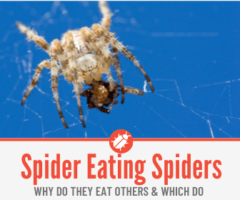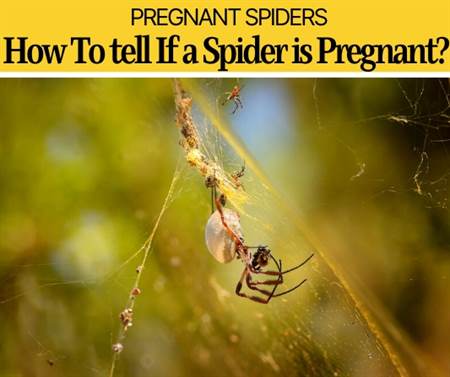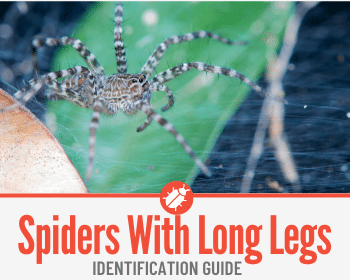 So, You’ve found a spider with long legs? Not sure what Kind of Spider is it and how to Identify it?
So, You’ve found a spider with long legs? Not sure what Kind of Spider is it and how to Identify it?
Heads up, it might not even be a daddy long legs, which is probably the first thing that comes to mind, right?
Below, we’re going to discuss what kinds of long-legged spiders could be in your house, whether they are poisonous, and how to get rid of these spiders with long legs.
Spiders with Long Front Legs
Have you come across a flat, short spider with long front legs? If so, it’s probably called a crab spider.
A crab spider is typically a bright white, green, or yellow color — sometimes brown or tan — and probably found hiding in dark places like inside your walls or under your porch.
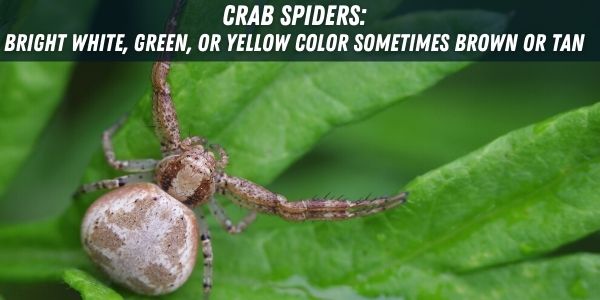
Granted, they are omnivores, so they help in getting rid of other pests (which of course is a plus for you).
Since they tend to stay hidden in a dim corner, you’re not as likely to run into one. However, if you do, you don’t need to fear too much.
They carry venom in their bite, but it is only harmful to other insects. (Whew!) Still, if you happen to be bitten by a crab spider it can get infected so just make sure to get it treated quickly.
A simple cleansing of the wound, and an anti-inflammatory will do the trick!
A crab spider bite is unlikely to happen since they only attack if they feel threatened, which is good news for us.
Still, who really wants one of these long legged crab spiders running around their house?
Brown Spiders with Long legs
If you’ve seen a brown spider, with long, very thin, wispy-like legs and a short, thin abdomen, it is very likely to be a Cellar Spider or Brown Recluse Spider.
Cellar Spiders are probably some of the most common types of spiders found in your house that has long legs.
Brown Cellar Spiders are often found in basements (hence the “cellar” in their name), and although are typically brown, can also be light yellow or gray.
These spiders are quite harmless to humans, and it is rare for them to bite. (Even if they did it wouldn’t matter since they don’t carry any venom.)
However, there is another kind of spider that fits a similar description and has Long legs: the Brown Recluse.
The brown recluse is just that, light to dark brown in color, and different from the cellar spider’s body shape, the brown recluse has a wider, oval-shaped abdomen (sometimes described as mirroring the shape of a violin).
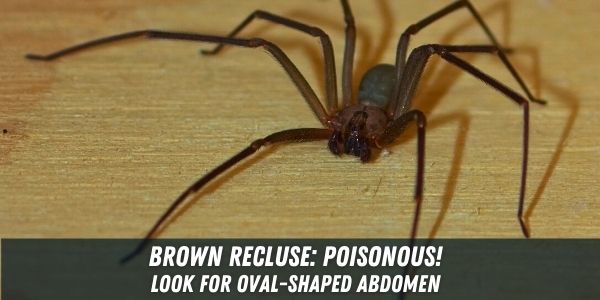
These spiders with long legs also differ from cellar spiders in that they are more commonly known to bite when threatened.
What is worse is that they are poisonous.
A brown recluse bite can be painful, and can even cause symptoms such as fever, nausea, itching, etc.
Though, in rare cases, the bite can be so harmful that it causes your living cells to die off (aka “necrosis”). If you suspect you’ve been bitten by a brown recluse, it is important to seek medical attention right away.
That being said, other times the bite is so small it doesn’t amount to anything. Still, it is always best to be prepared. In other words, be careful, especially since these spiders like to hide in inconspicuous places like inside shoes, clothes, or bedding. (Yuck.)
Black Spiders with Long Legs
This is probably the Black House Spider. These guys are dark brown to black, velvet to the touch, and legs longer than their bodies.
Despite their name, the black house spider lives both indoors and outdoors. When inside, you’ll find them in areas around windows and corners.
And if you were wondering, yes, the black house spider is venomous.
But, it is not dangerous to humans. And although it is uncommon for them to bite, it can occasionally happen, and when it does occur it can be painful.
If you’re starting to get worried, don’t fret too much.
These spiders are residents of Australia and New Zealand only. So, if you live in the Swiss Alps, or on the California coast, you should be good.
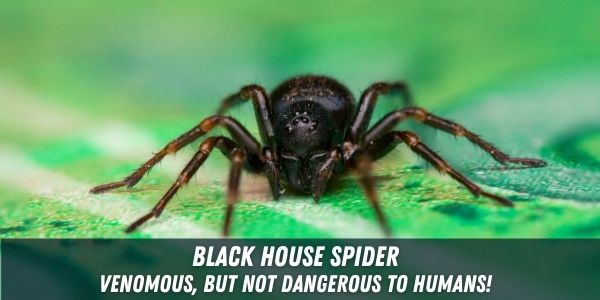
Red Spiders With Long Legs
Similar to the black house spider, this one has an unoriginal name: the Red House Spider.
These spiders are reddish-brown with legs longer than their body, especially their long front legs, and have a globe-shaped abdomen. Plus, they are quite small overall.
These little creatures can be found both indoors and outdoors (specifically in gardens), but really don’t bother humans.
Like most spiders with long legs, they won’t bite you unless they feel threatened or if their environment is being disturbed. Even then, the bite is completely harmless.
That is to say, it can be a painful bite despite their tiny size, so just be careful if you’re trying to purge them from your home.
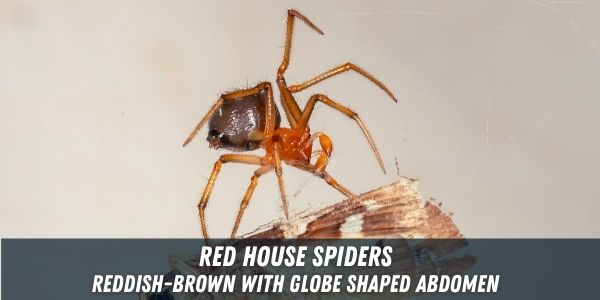
Green Spiders with Long Legs
Now, this spider with long legs actually has a pretty cool name, in my opinion: the Green Lynx Spider. (Sounds kind of like a superhero, right?)
The green lynx live all over the United States, though are most commonly found in Texas.
They reside specifically in lush greenery and gardens mostly, so you aren’t likely to find them inside your house, but rather in your yard.
These guys are pretty easy to distinguish, for their appearance is quite distinct: bright green body and long, thin legs of a pale green color with black spots. Plus, they jump!
The green lynx is yet again another kind of spider that is completely harmless to humans. They don’t commonly bite, and only pose a threat to other insects since they are indeed predatory spiders.
Thus, they can be beneficial to keep around (unless, of course, they end up eating other insects that are also natural pest-reducers).
Should you keep them around or not? Well, that’s up to you!
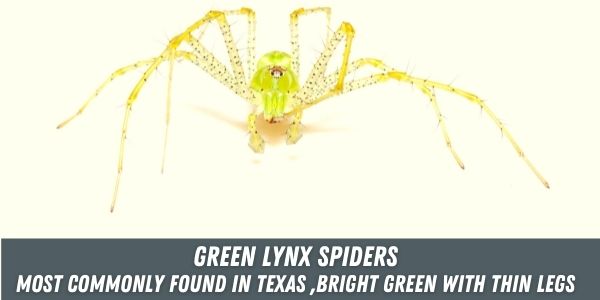
Small Spiders with Long Legs
If you see a spider with a very small body but very long legs, it is most likely some kind of Cellar Spider (ref. above “cellar spider”).
I say “some kind” because there are actually 20 different species of the cellar spider. Plus, they go by other names too, like daddy long leg, harvestman, vibrating spider, etc.
In other words, this one spider has been given a multitude of names as they are very common and have extremely long legs!
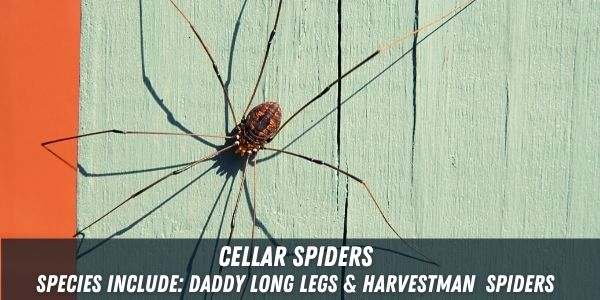
Large Spiders with Long Legs
Have you come across a particularly large spider that happens to have long legs too? Well, it could very well be what is called the Wolf Spider.
The wolf spider is brown, sometimes so dark they seem black, and can easily be mistaken for tarantulas due to their appearance.
They vary in size, though are generally on the larger side, with the largest one having legs up to 3+ inches in length. *shrieks internally*
You might find it reassuring to know that the wolf spider doesn’t typically reside indoors.
However, since the majority of their food consists of other insects, they can occasionally find their way inside if they’re following their prey.
Despite their forbidding-sounding name, they are not poisonous and therefore, not harmful to humans. (Thank heavens.)
Even if you were to get bitten by a wolf spider and you experienced any kind of uncomfortable side effect thereof, it would last only minutes.
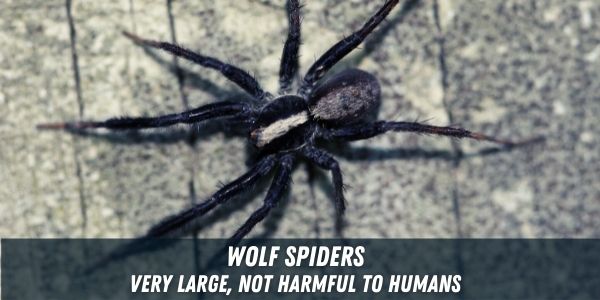
Spiders with Long Legs that Jump
Other than the Green Lynx, there is one other creature that fits this description, and that is the Spider Cricket.
Despite its name, this critter is not actually a spider. Indeed, it is a kind of cricket! It sure as heck looks like a spider, though.
They are brown with a humpback shape to their body. Not to mention, they have antennae and 6 long legs, with their back legs being even longer.
Oh, and yes, they do jump. In fact, they tend to jump straight at things that frighten them, so be wary when coming across one!
And if you do happen to get too close to these jumping spider crickets, you won’t have to worry about them biting you. Rather, they might gnaw on you, which can be just as painful, really.
I know what you’re thinking, and no, they’re not poisonous. Instead, they are quite the annoyance. Spider crickets can cause a lot of damage. They’ll feed off fungus, plants, carpet, cardboard, wood, etc. In other words, all things typically found within a home.
So if you’re scavenging around your house trying to find where they’re invading, look in any place that is dark and damp, like your basement or garage.
Continue Reading: Do Camel Spider Crickets Bite
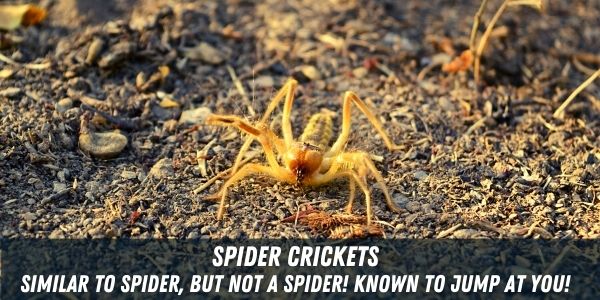
Spiders With Long Legs and Pincers
For this, there’s probably only one answer: the Pseudoscorpion.
Despite what its name suggests, this creature is indeed a type of spider. It sure does resemble a scorpion, though.
It’s ultimately just a spider with long legs and pincers. Other names for this spider include “false scorpion” or “book scorpion”.
These spiders are extremely small, only 2-8 mm in length (so small that some people mistake them for ticks — yuck). They are pear-shaped, brown, and have 8 legs plus a pair of pincers at the front that is twice as long as their legs.
Pseudoscorpions mainly feed off odd, tiny insects like clothes moth larvae, carpet beetle larvae, dust mites, and booklice. (Now you get why they’re also called a “book scorpion”… It may be time to give some of those books you’ve never read — but swear you will — a good dusting off!)
Related: Scorpions in Texas
Their natural habitat is outdoors in moist, dark conditions like under rocks, leaves, or tree bark, and the only time you’re likely to find them indoors will be in the spring or summer. Once indoors, they tend to migrate anywhere that is dusty and damp.
If you do find one squirming around in your basement or on your bookshelf, not to fret, they can’t even sting you with their baby-sized pincers. They are totally harmless. *sighs in relief*
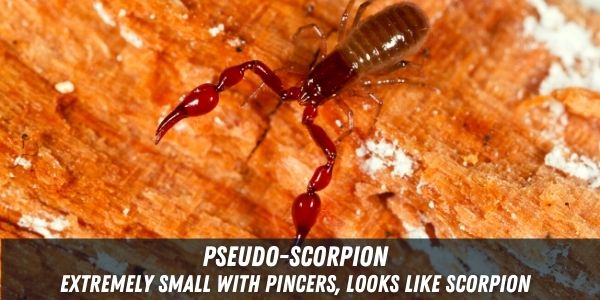
How Do I get Rid of Long-legged Spiders?
So not only have you found one of these spiders roaming about your home but a mass of them? Time to give them the ole boot.
There are numerous ways to get rid of these spiders with long legs.
You can choose to go a more natural route:
- Lemon
- Garlic & water
- Bleach
Use any of these above-listed ingredients and spray in the desired areas, and *bam*, you have yourself a homemade pest repellent.
Of course, you can take a more labor-intensive route as well and seal up all the cracks where the long legged spiders may be getting in from.
Or, perhaps you feel a little lazy (lazier than spritzing garlic water in the corners of your basement). If this is the case, just put a dehumidifier wherever it is these spiders are gathering.
If you haven’t noticed, many of these long-legged spiders we’ve talked about so far have something in common: they love damp environments. So, if you alleviate the dampness, you alleviate the spiders. Ta-da!
And, as always, you have the option of using a general spider repellant from your nearest home improvement store.
Needless to say, there are plenty of ways to get rid of these spiders.
Are Long-legged Spiders Poisonous?
As we have seen from what we’ve discussed so far, the answer is pretty simple: no.
Oftentimes, the long-legged spiders you find around your house or garden are not poisonous. Yes, they may bite when threatened, and yes, it may hurt, but it is not fatal.
There is only one spider we have mentioned thus far that defies the above statement: the brown recluse.
This formidable guy is the only one who actually poses a threat to humans. The rest are more nuisances.
But, if you’re anything like me, it might be wise to consult a doctor after you’ve been bitten by a spider, just to be on the extra-safe side.
In Conclusion
Ever heard the saying, “Spiders are more scared of you than you are of them”? Well, the spiders we’ve discussed here certainly make that expression ring true.
Now, I don’t know if they are literally scared of us, but I do know they don’t go out of their way to hurt us, and even if they do, we’re not going to die.
The next time you see one of these long-legged creatures, maybe you won’t jump in fright as much as you would’ve before.
Plus, you now know that not all spiders with long legs are actually daddy long legs (who would’ve thought?).
So, what eerie long-legged spider have you seen recently?


